The Unicorn Playbook: How Brands Accelerate to the Top
Every brand starts with an idea and slowly builds over time to create an empire, but what are the important building blocks to becoming a unicorn?
What is a unicorn brand and how do you get there?
In simple terms, a unicorn is a billion dollar brand. Unicorn brands you may have heard of include Nestle, Pandora, Panasonic, and of course, Pattern.
But how did these brands achieve unicorn status? Every brand starts with an idea and slowly builds over time to create an empire, but what are the important building blocks? We’re glad you asked.
To truly accelerate a brand from a vision to a unicorn takes 5 key competencies, across both design and ecommerce strategy. Creating a company that can thrive starts with careful design, and accelerating that company’s growth requires an all-encompassing strategy. Our Chief Revenue Officer, John LeBaron, and Chief Design Officer, Beau Oyler, outlined the 5 pieces of both creation and acceleration at the Silicon Slopes Summit 2021. Read on for a recap of their Unicorn Playbook presentation below:
5 core competencies to create a unicorn brand
Consumer insights
Everything in business comes back to knowing your customer and serving them well. To design a worthwhile product you need to truly understand your target audience–you need to get in their heads. The process of understanding your audience expects you to leave your preconceived notions at the door. It requires that you observe objectively and find empathy in your customers’ pain points. And above all, understanding your audience means looking at the cold, hard data to get an unbiased understanding. In this journey to understand your audience, you should come away with a clear idea of what your customers need, why they need it, and what kind of solutions they have been looking for.
When it comes to consumer insights, Enlisted Design, Pattern’s award-winning design agency, recently worked through understanding the audience on the launch of Beast Burgers. Beast Burgers comes from the larger brand Mr. Beast, which is both a YouTube channel and an individual social influencer. Mr. Beast creates contests and giveaway content that is extremely popular with a GenZ audience. And when the pandemic hit, Mr. Beast wanted to give back to the loyal followers that had made his career so successful, so he came to Enlisted with the following insights on his GenZ audience:
- Gen Z was being ignored by food brands.
- Gen Z kids were stuck at home due to COVID, and weren’t happy about it.
- Kids love burgers, but can’t get them because of being stuck at home due to COVID.
- Restaurants and delivery workers were still available, just slower in the pandemic.
- Every Gen Z is digitally native.
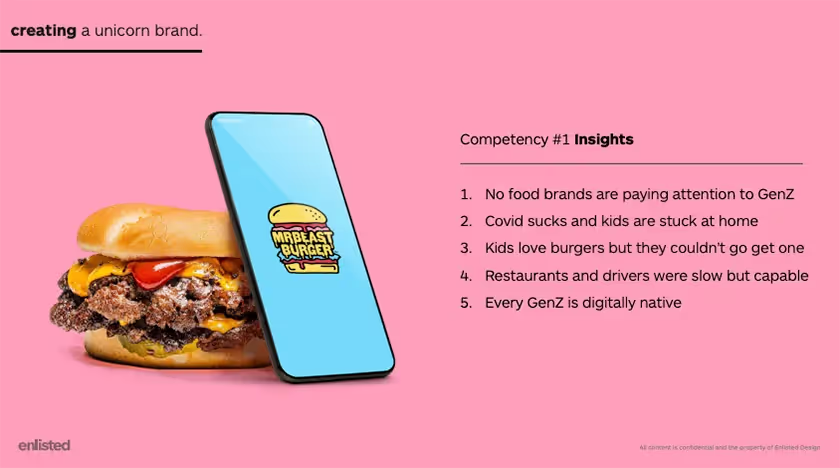
With those insights, Enlisted was able to create a solution that not only understood GenZ’s problems, but that provided a brand experience they could fall in love with.
Strategy
After finding consumer insights, the next step is to create a strategy that plays to those insights and actually touches on what the audience needs. A strategy is how you fulfill your brand vision; how you go from pain points to pleased customers.
With the insights about GenZ, Enlisted Design partnered with Mr. Beast to create a product that filled his consumers' needs, and Beast Burgers was born.
- Beast Burgers would deliver burgers, a product GenZ loved and was having trouble getting.
- Beast Burgers would be designed specifically for GenZ.
- Beast Burgers would come to GenZ so there was a bright spot to being stuck at home.
- Beast Burgers would utilize ghost kitchens and give the capable restaurants and delivery workers efficient recipes and a new line of work.
- The experience would be, start-to-finish, digital. Beast Burgers would be ordered online, no physical counter or drive-thru, and the advertising would be done where GenZ already was—online.
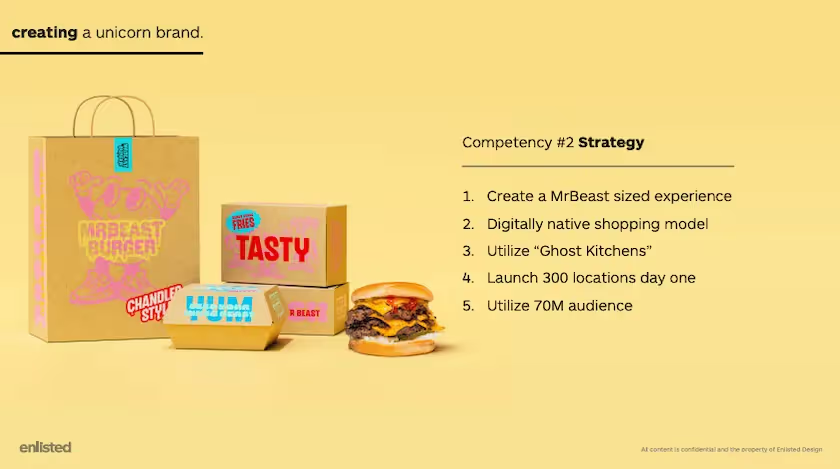
The fulfillment of a strategy that plays off of individual consumer insights goes hand-in-hand with creating a living, breathing brand.
Brand
A brand is more than a title and a logo, according to Beau Oyler, CEO of Enlisted Design and Chief Design Officer at Pattern.
“A brand is essentially a manifestation of a company, a product, or a person, and that brand has so many different touch points to target the consumer. When done right, each of these touch points create a cohesive brand experience.”
Those touch points make up every part of the buyer’s journey, both digital and physical. From advertising to unboxing, and from web design to in-store returns, branding is how you unify every aspect of your offering.
With Beast Burgers, branding created a start-to-finish GenZ, digital experience—with every touchpoint accounted for. The brand guidelines, graphic design, and fonts were all created to be playful, digital, and in-touch with the audience, but the design didn’t stop there. It bled into naming the burgers, creating the recipes, and directed the language used to describe both the product and the brand. Ultimately, everything was designed to create brand buy-in from the audience at an emotional level.
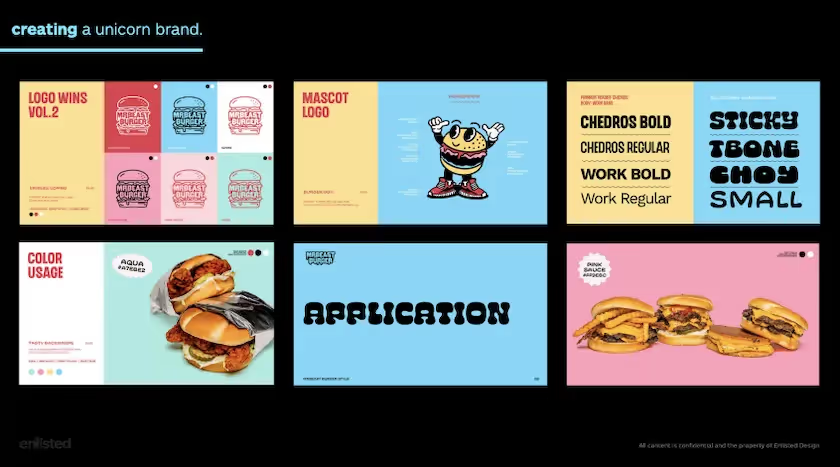
“There's this emotion of desirability that some products have. It's very difficult to create that emotional connection. But ultimately, when it's created, the consumer begins to lust after that thing. And then once they adopt it into their lives, that becomes who they are, or part of who they are,” Beau said. “We want that. We want them to lust and love our products and our brands, because then they're going to use them, they're going to love them, and they're going to advocate for them.”
CEOs can have a killer idea for a product or an air-tight strategy, but if they miss the key ingredient of humanizing the brand, then no amount of acceleration can drive a brand without soul. To succeed in creating a brand and not just a company, you have to consider every detail that might create an emotional connection, from the digital presence to the product packaging.
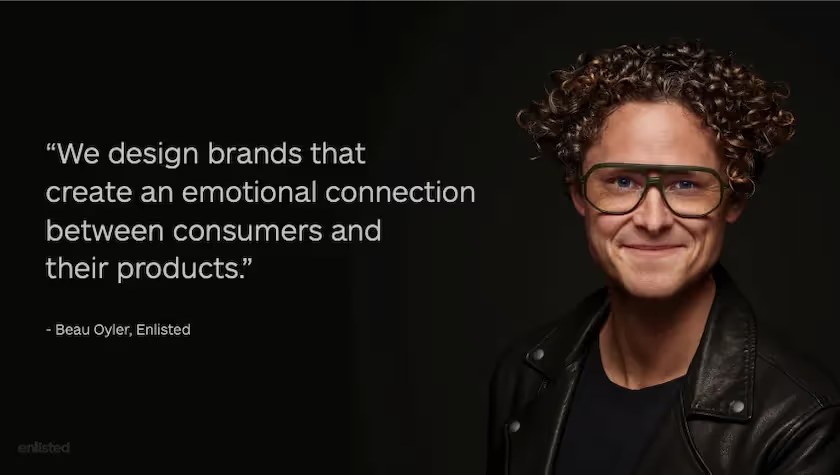
Packaging
After gathering consumer insights, a strategy to fulfill those insights, and humanized branding, you’re ready to package everything together for the consumer and get the product in their hands. Often the product packaging will be the first physical experience a consumer has with your brand, and first impressions matter.
With Allbirds, Enlisted took on the massive task of producing on-brand packaging in a considered form factor. Consideration being a key piece because shoe boxes aren’t often considered, they’re mass manufactured to be exactly what the consumer has always seen. There was no elevated branding or emotional tie to the idea of shoe packaging.
However, to stay on-brand for Allbirds, Enlisted needed to fulfill color requirements, size requirements, and sustainability requirements. So the designers dug deeper. Shoe boxes have always been the same simple box, but what can we do to create one box shape that will house every size? And how can we make it sustainable? No, how can we make it biodegradable?
By ignoring the ‘classic’ shoe-box shape and opting for materials like sugarcane, Allbirds created an innovative and considered package that was honored in Fast Company’s 2021 Innovation by Design Awards. The final package was a black, fully biodegradable shoe case that could hold every size of shoe it would carry.

Packaging matters, and just like packaging, a product is so much more than it’s name or physical shell. A product is an experience with the potential to create a community in and of itself.
Product
A product is more than the object your brand sells, it’s a chance to tie in consumer insights, branding, and strategy to produce an end result—solving problems your consumers face. Take Arlo security cameras; consumers didn’t want another piece of tech in their home, but they wanted a way to easily understand what was going on at home. So, from end-to-end, Arlo was about being homeware that was more communicative than intimidating. The idea wasn’t to skimp on tech, but to serve the consumer's needs. The result? A DIY security camera design that evolved into a system, and that system turned into a design language. And now that camera, system, and design language have over 30 products that all sprung up from a product that was focused on being more than just another piece of hardware. On top of a successful product line, Arlo’s innovation allowed them to have the largest IPO in IOT history, showing the value that design can bring to business.
Somewhere between understanding the end customer, unifying the brand touchpoints, and fulfilling the vision, a unicorn brand is born. But existing as a unicorn with a strong offering can only take a brand so far—they’ve got to find a way to reach their full potential across markets, marketplaces, and overall ecommerce. No matter how perfect a product and brand design is, it still needs a platform to accelerate its digital presence.
5 core competencies to accelerate a unicorn brand
Data insights
In designing a product and creating a brand, we used consumer insights to understand what the target audience needs and why. Going one step further, consumer insights data helps us understand where and what the target audience is looking for. Using that data, you'll find opportunities to accelerate your brand that you didn’t even know existed.
At Pattern, we use data to learn what space there is for new products, what keywords customers are searching when they are looking for a product like yours, and what keywords competitors are and aren’t using to attract customers.
Using our Predict platform, we actively monitor 3 million keywords a day, and we’ve been aggregating that data for years. On top of all that data, we are dissecting more than 30,000 different categories and subcategories on Amazon to understand not only what keywords matter, but how they matter in their space.
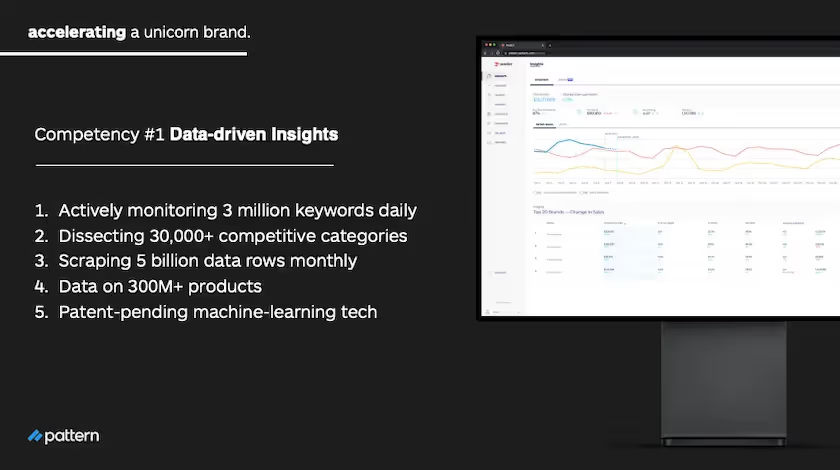
Here’s the power of data in action. If your brand came to Pattern and asked us if face masks are a good category to go into, our data would tell you that face masks are an amazing category. There are more than 12.5 million searches every month—just on Amazon US—related to face masks in this category. Keywords like “face masks for men,” “women disposable face masks,” “moisturizing face masks,” etc., are just a few examples of keyword searches.
So are face masks a good Amazon category to launch in? We let the data speak for itself—the category is growing more than 150% every single year, and from a competitive standpoint on the HHI index it's a 7.1, which is very, very good.
Additionally, it's a very fragmented category, which means that you can win. The entire category itself only has 221,423 reviews. In some categories, you’ll get a product with 25,000 reviews on one product alone, making it hard to make noise for yourself with a new launch. But in face masks the reviews are spread thinner, meaning your ability to penetrate the market and actually win is quite high.
These are the types of data insights that can help not only build a brand but understand what the opportunities are. If your brand came to us already in the face mask space but not seeing the benefit of the opportunity we’ve described, we can dive back into the data to find out what keywords opportunities you’re not taking advantage of—does your description mention disposable or just a sheet mask? Does your listing silo your product to 1 gender? Should it? It depends on the category. This type of granular insight is what helps drive the next piece of the playbook: traffic.
Traffic
Having data insights can only do so much for you if you don’t use them to their fullest extent. In order to accelerate your brand online, you have to be really good at getting traffic. If you have the best product in the world but no one can find it then, unfortunately, no one can buy it.
Data insights around keywords help you uncover user searches that match your product that you, and maybe your competitors, aren’t paying attention to. On top of organic keyword opportunities, data gives you insights around paid keyword opportunities. With our ecommerce acceleration software Predict, you get both.
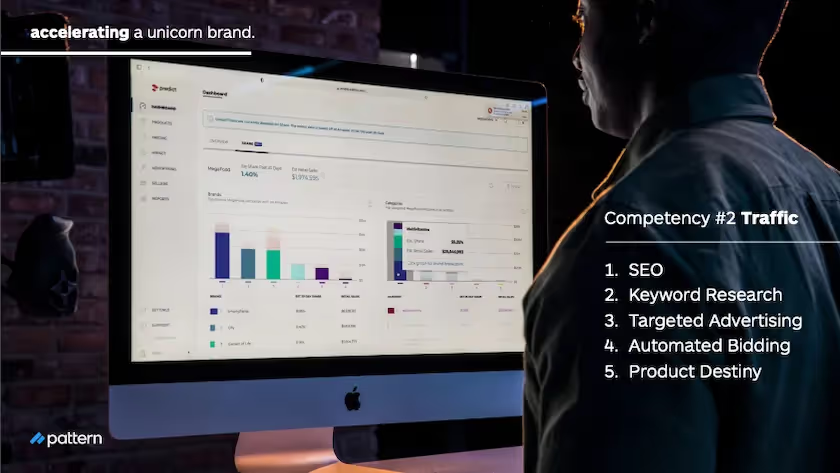
Our Destiny methodology identifies the keywords you need to bid on in order to rank better organically. Then, once you rank well you can move on to advertising and boosting different keywords, and we’ll help you continue the cycle until you own your industry.
The true secret of traffic for acceleration? It can’t be manual. You must have a platform that automates keyword research and analysis, ranking monitoring, and advertising optimization.
“Think about the US stock exchange,” said John LeBaron, CRO at Pattern. “Fifteen to twenty years ago 90% of all trades happened manually. Today, more than 90% of futures volume, or equity volume, in the United States is happening through algorithmic, programmatic HFT—or high frequency trading. The same thing is happening in ecommerce on keywords, on advertising. If you are not using programmatic or algorithmic bidding in what you're doing, you are going to lose.”
Our platform automates, arbitrages, and performs millions of “trades,” or bids, dynamically. For example, using product Destiny, we took Feetures from ranking on longer-tail terms like ”‘no show athletic socks black” to parent keywords like “no show socks.”
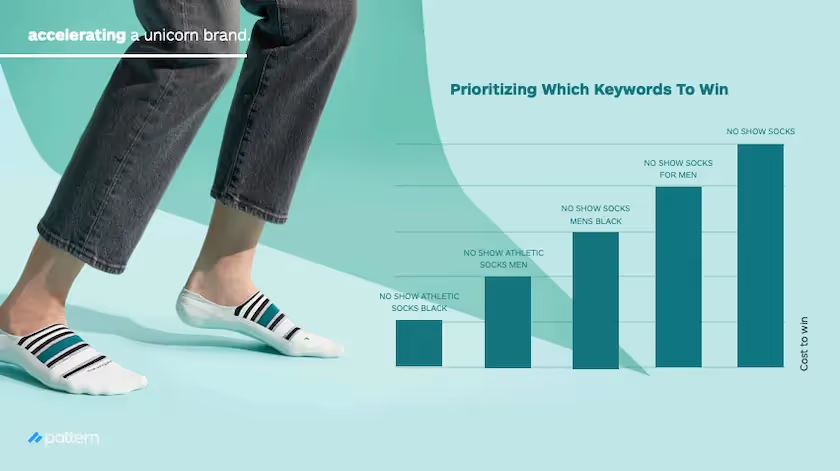
The machine analyzes where the brand is at, what the opportunities are, and goes to work spitting out new keywords and trying to bid against them. It might increase the bid or might lower the bid until Feetures starts ranking on longer tail keywords like “no show athletic socks black,” then starts to win on “no show athletic socks man,” and then starts to grow, all the way up to getting domain authority on terms like “no show socks.”
Why do we spend the time on this? Because driving traffic is huge for accelerating a brand. You want as many qualified consumers as possible to know you exist, and the best way to do that is to get in front of them when they are looking for a solution like yours. Sadly, getting in front of the right customers won’t do the job alone—you’ve also got to convince them to buy, which leads to optimizing your content.
Content
The term content is a wide net that catches images, video, bullet points, product descriptions, reviews, and yes, A+ Content on ecommerce. Content is where you show and explain to potential shoppers what your value is, and how you can solve their pain points. Designing an informative, engaging product listing page is one of the most effective ways to turn browsing shoppers into customers.
Looking at Owlet, for example, we redesigned their image stacks to give consumers the information they needed as quickly as possible. The average person reads only 20% of a web page, but will view every image, giving images huge power in consumer decision making. To nail our images, we use sentiment analysis to analyze the reviews and find out what questions people are having, what expectations the product is missing, and then we illustrate the answers right away. This allows users to self-select as the right audience and truly understand what they are buying from the get-go.
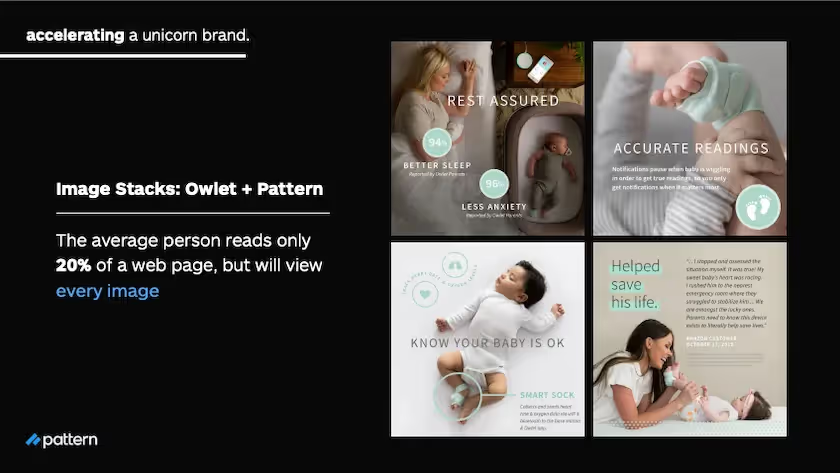
And it works. Owlet reported a 43% growth in business in Q1, which is great, but we know their Amazon business was growing close to 70%. High-quality images, detailed product descriptions, and consistent branding are all content pieces that will truly improve conversion, and we’ve seen it happen.
Another great example is Popsockets. When our partnership with Popsockets started, we changed nothing except improving the content. We wanted images that showed the product in action instead of just highlighting the colorful designs. Using the traffic they were already generating, our content pushed the conversion rate up 49%. Sometimes you don’t need to throw more innovative ideas, advertising dollars, or full-blown campaigns at a low-performing product, you just need to tweak what you’ve already got going.

But the ecommerce story doesn’t end there. Once you’ve put work into getting traffic and converting it with top-notch content, then you’ve got to worry about protecting your brand against unauthorized sellers, price erosion, and counterfeit copy-cats.
Protection
You put in enough time and market research pricing your product correctly in the first place, so it’s important that you protect your ability to maintain and control that price once your product hits the market. Tracking and enforcing Minimum Advertised Price (MAP) can make the difference between stagnation and acceleration.
A key element of MAP enforcement comes from identifying and removing unauthorized sellers, who get ahold of your product and sell it for less than they should. Because once one seller has a lower price, all other sellers have to lower their prices to match or they’ll always lose out on the sale. But then as prices get lower, profits get lower, and sellers are less likely to choose your product to carry in the future.
We worked with a brand whose distribution and price monitoring got out of whack. With no compliance on pricing, they were 18 months into a release when they found out that they were selling below product cost. We implemented a strategy of monitoring, reporting, working with 3rd party legal entities, and shopping on their behalf to understand where the product was getting diverted and how it was getting there—all of this to help them get absolute control of their distribution channel and return to selling at their chosen price.
The most rewarding part? We’ve had brands who’d been working with big-name attorneys and had struggled to see our same results, showing us that not only does our playbook work, but our platform is the most effective way to accelerate.
Logistics
Just like you want to protect your brand from shady distribution to avoid unauthorized sellers, you want to ensure you have strong logistics to get your product to the end customer quickly and cost-efficiently. Every part of the Unicorn Playbook hinges on this final piece, because having the perfect product and getting it in front of the perfect consumer with a perfect price won’t matter if they can’t actually get your product in-hand.
Oftentimes brands will find that fulfillment tends to be the most expensive part of the ecommerce equation. Shipping containers, moving product, taking care of packaging—it all adds up. So whatever you can do to use data to solve problems and find efficiencies can go a long way for brand acceleration.
One of the things we do is put our machine learning across products and tier sizes. For example, Amazon charges different fees to ship your product depending on the size, and we found that one brand we work with was 0.2 inches over the next size threshold. So, we explained the data and pitched decreasing their package size by 0.2 inches. They are now saving $65,000 a month, just because they knew to make one small packaging change on one product thanks to automated logistics insights.
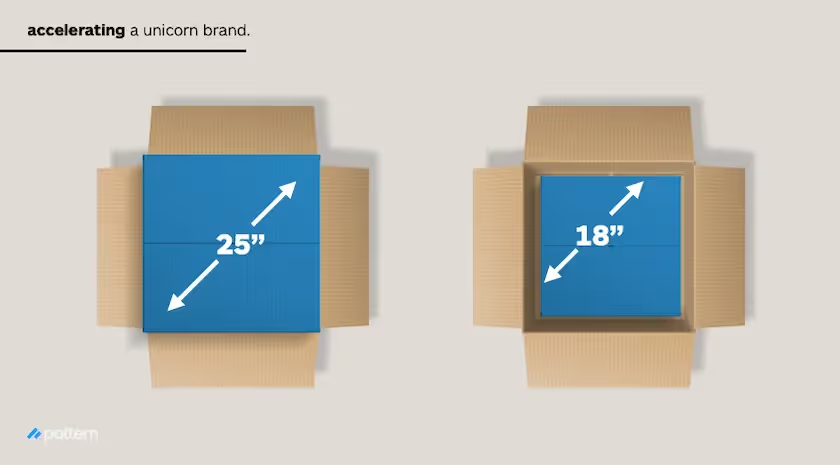
Another example was finding a solution for Yogi Tea to ship their small, inexpensive products. We decided to combine their products and sell bundled sets instead of just single products. This wasn’t something they could handle in-house, so we did it for them. We packaged their products into a bigger, bundled product, and now it’s a top seller.
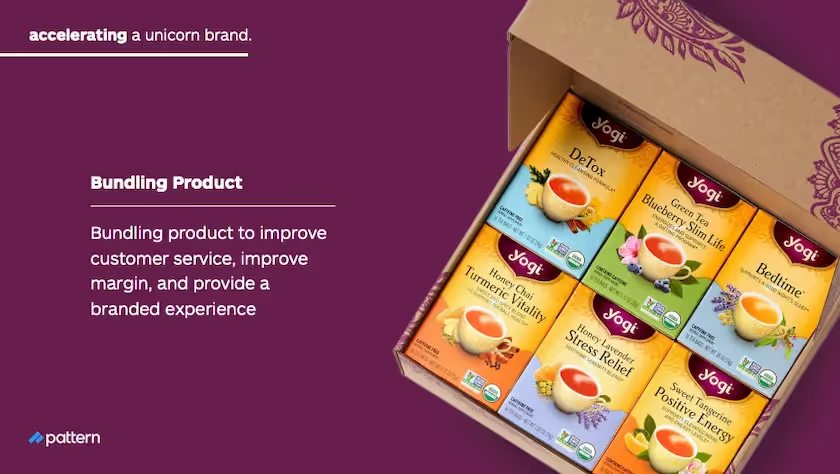
Be the next unicorn with Pattern and Enlisted Design
In summary, unicorn brands don’t just happen, they are created and accelerated through meticulous strategy and optimization. It takes data and great design to build a unicorn brand that resonates with consumers.
With Enlisted Design’s track record of creating next-level brands around the world, and Pattern’s expertise in expanding next-level brands across markets, marketplaces, and overall ecommerce, a Pattern and Enlisted combo is poised to turn you into the next unicorn.
As a unified partnership, we work together to fill the gaps in design, product, and marketing to ensure your brand is at the leading edge of your industry. We help you get the right product, on the right platform, in front of the right person. We don’t sell brands a design package or software suite that they don’t know how to use or don’t have enough people to manage—we partner with brands to accelerate their creation and growth.
Interested in learning more? Enlisted’s branding expertise will take your product to the next level, and Pattern’s ecommerce chops will ensure your brand accelerates to achieve its full revenue potential. Get in touch here.


.jpg)





.jpg)

